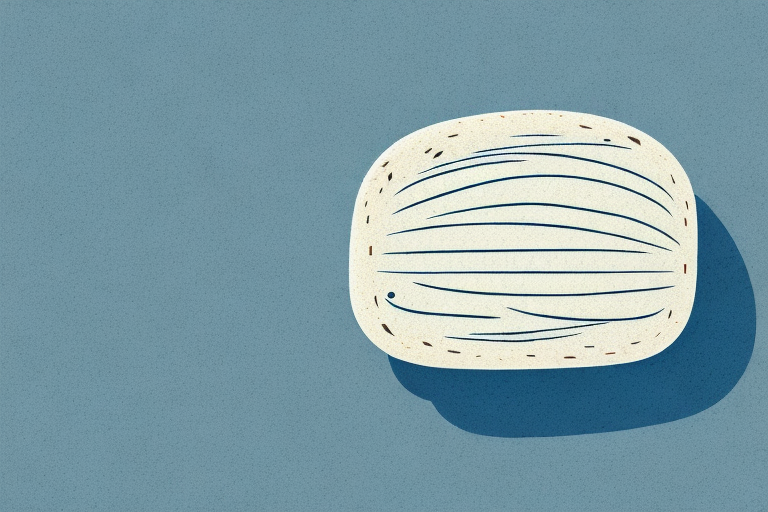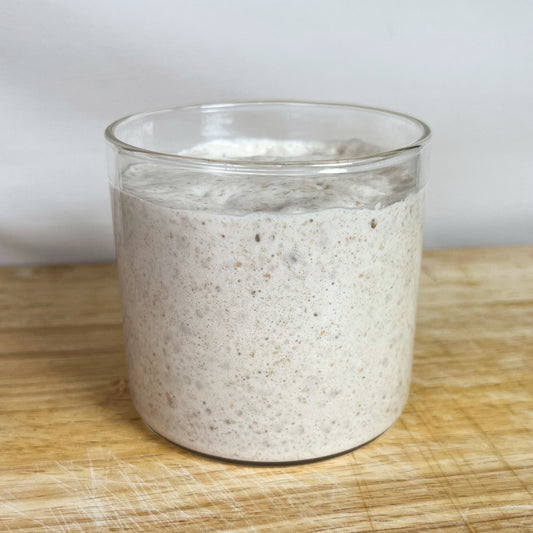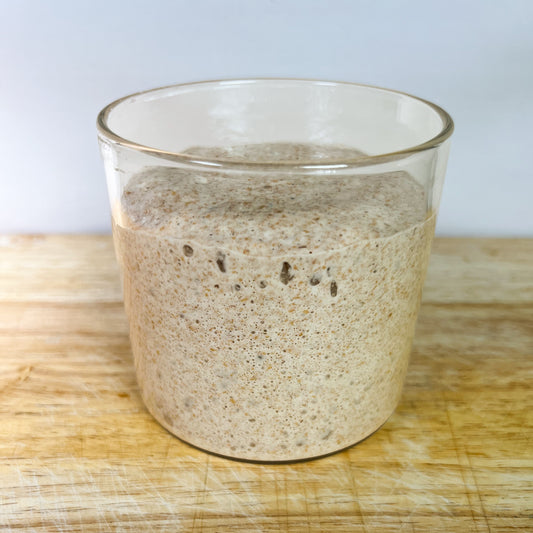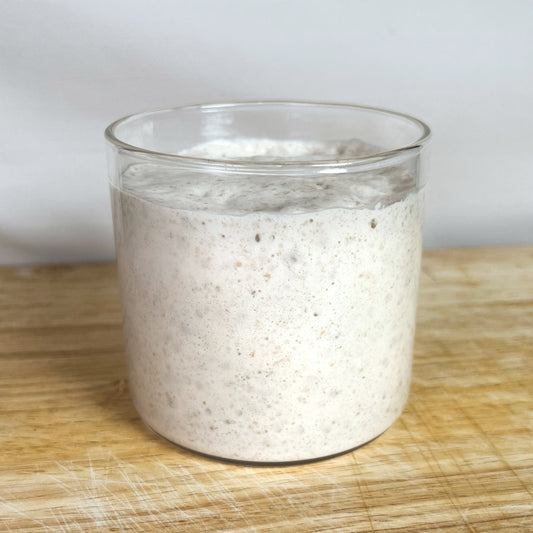Sourdough Bread Scoring for Beginners: Step-by-Step Guide with a Bread Lame

Sourdough bread is a staple in many households, but have you ever wanted to learn how to score your bread like a pro? Scoring is the process of making incisions on the surface of the sourdough bread to control its expansion during the baking process. This step is not only aesthetically pleasing but also helps the bread rise evenly. In this comprehensive guide, we will cover everything you need to know about sourdough bread scoring with a bread lame.
Understanding Sourdough Bread Scoring
Sourdough bread scoring involves making shallow incisions on the surface of the bread dough before baking. This process is important because it allows the bread to expand and rise evenly during baking, resulting in a beautiful and delicious loaf. But there's more to scoring than just making a few cuts on the surface of the dough.
What is Sourdough Bread Scoring?
Sourdough bread scoring is the process of making a series of shallow incisions or cuts on the surface of the bread dough before baking. The cuts can be made in various patterns, including straight lines, crosses, or even intricate designs. These cuts serve two purposes: first, they allow the bread to expand and release steam during baking, resulting in a crusty and delicious loaf. Second, they create a beautiful and unique design on the surface of the bread.
Why is Scoring Important for Sourdough Bread?
Scoring is important for sourdough bread because it helps control the expansion of the dough during baking. When bread dough is baked, it expands as the yeast produces carbon dioxide gas. If the dough is not scored, it may expand unevenly, causing it to crack or even deflate or not to cook fully. By making shallow cuts on the surface of the dough, the baker can control the expansion of the dough and ensure that it rises evenly.
Scoring also plays a role in the texture and flavor of the bread. When the dough expands and releases steam during baking, it forms a crust on the surface of the bread. The cuts made during scoring allow the steam to escape and prevent the crust from becoming too thick and hard. This results in a crusty yet tender loaf of bread.
The Role of Bread Lame in Scoring
A bread lame is a blade attached to a handle used for scoring bread dough. It is typically made of razor-sharp stainless steel and has a curved or straight edge. The bread lame is an essential tool for sourdough bread scoring because it allows you to make precise and shallow cuts on the surface of the bread dough efficiently.
When using a bread lame, it's important to hold it at a shallow angle to the surface of the dough. This ensures that the cuts are shallow enough to allow the dough to expand and rise evenly. The baker can also experiment with different patterns and designs to create a unique and beautiful loaf of bread.
In conclusion, sourdough bread scoring is an important process that plays a crucial role in the texture, flavour, and appearance of the bread. By making precise and shallow cuts on the surface of the dough, the baker can control the expansion of the dough and ensure that it rises evenly. With the help of a bread lame and a little practice, anyone can master the art of sourdough bread scoring.
Preparing Your Sourdough Bread for Scoring
Before scoring your sourdough bread, there are a few things you need to consider. These include the dough consistency, shaping, and final proofing.
Choosing the Right Dough Consistency
The right dough consistency is crucial for successful sourdough bread scoring. The dough should be soft and pliable but not too sticky or wet. Achieving the right consistency can be a bit tricky, but it comes with practice. One way to test if your dough is ready is by performing the "windowpane test." This test involves taking a small piece of dough and stretching it gently until it becomes thin enough to see through. If the dough stretches without tearing and you can see light through it, then it's ready.
If the dough is too wet, it will be challenging to score, and if it is too dry, the bread may not rise as well. If you find that your dough is too wet, try adding a little flour at a time until it reaches the desired consistency. If it's too dry, add a little water.
Shaping Your Sourdough Loaf
Shaping your sourdough loaf is an essential step before scoring. A well-shaped loaf will produce a great crust and allow for even expansion during baking. There are many ways to shape your loaf, and each baker has their own preferred method. One popular method is the "coil fold" technique, which involves folding the dough in on itself several times to create a tight ball.
Another popular method is the "boule" shape, which involves shaping the dough into a round ball. To shape your loaf, begin by gently folding the dough into a tight ball, and then stretching and tucking the edges under until a smooth surface is formed.
Final Proofing and Prepping the Surface
Before scoring, the dough needs to undergo a final proofing stage to rise fully. This is typically done on a floured surface, and the proofed dough should have a smooth and firm surface. The final proofing stage can take anywhere from a few hours to overnight, depending on the temperature and humidity of your kitchen.
Just before scoring, dust the surface of the dough with a little flour or cornmeal to help the blade glide smoothly over the surface. This will also help create a beautiful, rustic crust on your bread. You can also experiment with different scoring patterns to create unique designs on your loaf. Some popular scoring patterns include the classic "cross-hatch" pattern and the "ear" pattern, which involves making a deep slash at an angle to create a "ear" on the side of the loaf.
With a little practice and experimentation, you'll soon be scoring beautiful and delicious sourdough loaves like a pro!
Bread Lame Basics
Now that you have prepped your dough for scoring, it's time to learn the basics of using a bread lame.
Scoring your bread dough is an essential step in creating beautiful artisanal bread. A bread lame, also known as a scoring tool, is a small, handheld tool used to make precise cuts in the dough before baking. These cuts allow the bread to expand and rise evenly in the oven, resulting in a crispy crust and a soft, airy crumb.
Read more here: Choosing the Right Bread Lame: A Buyer's Guide
Types of Bread Lames
There are two main types of bread lames: curved and straight. Curved lames are commonly used for scoring round or oval-shaped loaves, while straight lames are suited for rectangular or oblong-shaped loaves.
Some bakers prefer to use a curved lame for all types of bread, as it allows for more fluid movement and easier control. However, it's always a good idea to experiment with both types and see which one works best for you and your bread.
How to Hold and Use a Bread Lame
Before using a bread lame, make sure your dough has been properly proofed and is ready for scoring. Hold the bread lame with your dominant hand, and place your other hand on the dough to steady it.
Make shallow and even cuts at a 45-degree angle, using the curved or straight edge of the blade depending on the shape of your loaf. It's important to make swift, confident cuts without pressing too hard, as this can deflate the dough and affect the final texture of your bread.
Experiment with different scoring patterns and designs to create unique and beautiful loaves. Some popular designs include the classic crosshatch, the single slash, and the leaf pattern.
Bread Lame Safety and Maintenance
Always handle a bread lame with care, as the blade is razor-sharp. When not in use, store your bread lame in a sheath or cover the blade with a cap to protect yourself and others from accidental cuts.
Keep the blade sharp by regularly dry sharpening it with a sharpening stone or honing rod. Avoid using water or oil to sharpen the blade, as this can damage the tool and affect the quality of your cuts. There are also lames that come with razors which can be easily replaced.
With practice and patience, using a bread lame can become a satisfying and enjoyable part of your bread baking routine. Happy scoring!
Scoring Techniques for Sourdough Bread
Now that you understand the basics of sourdough bread scoring and using a bread lame, it's time to explore some scoring techniques and designs. Scoring is an essential step in the bread-making process, as it allows the dough to expand and release steam during baking, resulting in a beautiful and delicious loaf.
Simple Scoring Patterns for Beginners
If you're new to sourdough bread scoring, start with simple patterns like a single slash or a cross. These patterns are easy to create and will still allow your bread to expand and rise properly. To create a single slash, make one long, shallow incision on the surface of the dough. To create a cross, make two shallow incisions that intersect.
Another simple scoring pattern to try is the tic-tac-toe pattern. This involves making three shallow incisions horizontally and three shallow incisions vertically, creating a grid-like pattern on the surface of the dough.
Advanced Scoring Designs and Techniques
For more complex designs, try creating a diamond pattern, a sunburst pattern, or even a spiral. These designs require more skill and practice but can add an aesthetic touch to your sourdough bread. To create a diamond pattern, make diagonal incisions in opposite directions, creating a diamond shape. For a sunburst pattern, make several shallow incisions in a circular pattern, radiating out from the center of the dough. To create a spiral pattern, make a continuous, curved incision around the dough, gradually moving towards the center.
Another advanced scoring technique to try is the ear. This is a raised flap of dough that forms when the bread expands during baking. To create an ear, make a deep, diagonal incision on the surface of the dough at a 30-45 degree angle.
Tips for Clean and Precise Scoring
To achieve clean and precise scoring, make sure your bread lame is sharp and your cuts are shallow and even. Use a swift and fluid motion when scoring, and don't hesitate or waver. It's also important to score the dough just before baking to ensure the cuts are still visible after rising. Practice makes perfect, so keep practicing until you achieve the desired result.
Scoring sourdough bread can seem daunting at first, but with practice and the right tools, it becomes an artistic and enjoyable step in the bread-making process. Experiment with different scoring patterns and techniques to create unique and beautiful loaves of sourdough bread.





